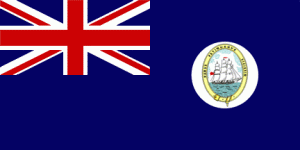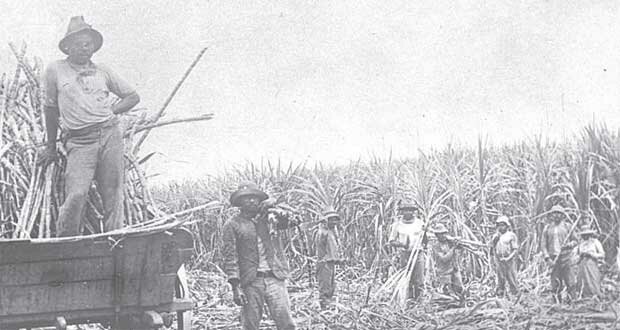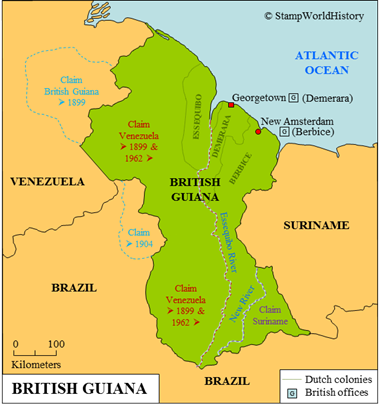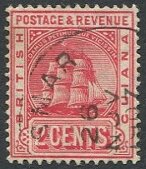
British Guiana
Quick reference
General issues: British colony 1850-1961, British colony/Self government 1961-1966
Country name on general issues: British Guiana
Currency: 1 Dollar = 100 Cents 1850-1966
Population: 287 000 in 1900, 661 000 in 1966
Political history British Guiana
Colonization and transfer to British rule
British Guiana is located in South America. Before colonization, the population consisted of several Amerindian peoples. The most important of these were the Arawak and the Carib – peoples widely found along the northern coast of South America and in the Caribbean. The Dutch were the first Europeans to settle in the future British Guiana, establishing themselves in Essequibo in 1616. The Dutch eventually established three colonies: Berbice, Demerara and Essequibo. In the late 18th and early 19th century, the colonies changed hands between the Dutch, the British and the French. In 1814, the colonies were awarded to the British, the Dutch formally ceding the colonies in 1815. The British united the three colonies in 1831 to form British Guiana.
Disputed borders
British ambitions went beyond the three colonies ceded by the Dutch. The British explored and settled lands further west. Lands, all lands west of the Essequibo River, that were claimed by Venezuela as early as 1824. The dispute with Venezuela would last all through the 19th century. In 1899, a settlement was reached through arbitrage establishing the border – awarding most of the disputed territory to Great Britain. Venezuela would, in 1962, revoke its signature under the 1899 settlement on legal grounds and revert to its original claim on all the lands west of the Essequibo River. The dispute has yet to be settled.
Not only the border with Venezuela is disputed, so is the border with Suriname. The dispute with Suriname is focused on the New River Triangle – de facto administered by the British from 1843 and awarded to the British in the 1899 settlement. The Dutch – then in possession of Suriname – have formally protested the 1899 settlement, the protest being turned into an official claim in 1962. The claim is upheld by the Suriname government until today.
The border with Brazil is the only border that has been undisputed since it was settled in 1904.
Economic and political developments

Cane cutters at work – Sugar cane was in the 19th century the only and well into the 20th century the most important source of income for British Guiana.
The British continued the Dutch policy of developing British Guiana as a plantations colony. Throughout the 19th century sugar cane was the major cash crop. To man the plantations slaves were brought to British Guiana until the abolition of slavery in 1834. From then, large numbers of Indians from British India were brought to British Guiana. The Indo-Guyanese and the Afro-Guyanese are, until today, the largest population groups in the country. As the demand for sugar cane was falling, in the late 19th century the economy was diversified to include other crops – rice – and mining – bauxite and gold.
Politically British Guiana has, from the 1940’s, gone through a number of steps towards self government. Self government was eventually gained in 1961. In 1966, British Guiana became independent within the British Commonwealth as Guyana. Guyana was proclaimed a republic in 1970.[1]Guyana is the traditional name for a large geographical region in South America between the Orinoco and Amazon rivers. Several countries, and parts of countries, have derived their name from the region. The name is spelled alternatively Guyana, Guiana, Guayana or Guyane.
Postal history British Guiana
The first stamps issued for British Guiana appeared in 1850 and were issued locally by the postmaster of Georgetown. The design was a circle inscribed ‘British Guiana’. These issues were initialed at the post office before use. From 1852, stamps were supplied from London but until 1882 several local issues were required to meet demand. The early issues from British Guiana – both the local and the London issues rank in the high to very high catalog value ranges. The locally issued 1856 ‘Black on Magenta’ currently ranks as the worlds most expensive stamp – only one copy is known. The issues before 1931 almost all show a sailing ship – the seal of the colony is also shown on the flag. From 1931, the issues are of designs specific for British Guiana, but in a style common to the British colonies. British Guiana has joined in several of the British omnibus issues. The last stamps of British Guiana were issued in 1966, to be superseded by the issues of Guyana.
Until 1856, the stamps of British Guiana were valid only for domestic mail. International mail had to be franked with stamps of Great Britain at offices in Georgetown[2]Then known as Demerara. and New Amsterdam [3]Then known as Bernice. .
Album Pages
← Previous page: BrazilNext page: British Honduras →




